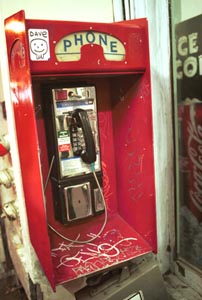![[Metroactive News&Issues]](/gifs/news468.gif)
[ San Jose | Metroactive Central | Archives ]
 Receiving End
Receiving End
Hard hit by competition from the cellular industry, pay phones aren't ready to hang it up yet
By Dara Colwell
IN THIS ERA OF personal, wireless and handheld, another cultural icon may be going the way of the Dodo: the pay phone. While finding a pay phone--any pay phone--often proves an elaborate task, using one that isn't grimy, battered by the elements or surrounded by abandoned diapers is a rarity even Superman could appreciate. Even so, for those of us who have resisted wireless's seductive call, the growing dearth of pay phones can be problematic. "I have to check in with my babysitter," says Angelina Garcia, clearly rushed on a rain-splattered day. Garcia spent 20 minutes circling through San Jose's congested streets trying to spot a coin-operated machine to place her call. "Now I'm really running late," she says, choosing one of four dripping phones outside the 7-Eleven on Santa Clara Street. Since 1985, when the total number of cell phone users hovered at a modest 203,000 nationwide, the cell phone's popularity has skyrocketed. Now, nearly 100 million subscribers have opted to go wireless, according to the Cellular Telecommunications Industry Association, and that number is expected to double in the next two years. With a mere 1.6 million pay phones scattered across the states versus the current 80 million cell phones in use, this could very well be the death knell of the public handset. "The erosion started with the advent of attractive bucket pricing plans in 1998-1999," says Tom Keane, president of the California Pay-phone Association. But Keane, who has been tracking the shift to wireless and estimates that 20 percent of California's pay phones were pulled out of service last year, doesn't see this as the end. "People who use [pay phones] rarely do it because they're just killing time--it's because they're not at home or at work. And," he adds pragmatically, "when a cell phone battery runs out, you'll need a pay phone." But the costs of maintaining a pay phone are expensive. According to Keane, pay phones cost $2,200-$2,500 per unit, and with installation, labor and location charges adding up to about $1,000, in order to pencil out, a pay phone needs to produce revenue from 500 to 600 calls a month to make a profit. That's a lot of quarters and dimes. Also, pay phones make their money both on the coin box and on the compensation, known as "dial-around compensation," that providers are supposed to receive from the carrier. So, for example, when a caller uses an 800 number such as AT&T's, AT&T is required by the Federal Communications Commission to pay 24 cents per call to the pay phone provider. But often, that doesn't happen. "We effectively make 60 cents off every dollar. The FCC didn't make any ruling on bad debt," Keane says. Of course, demographics show that pay phone use is skewed toward those who have less income. According to the Federal Communications Commission, which put out a subscriber report in April this year, 5.7 million Americans currently do not have a telephone at home. For those with an annual income of $16,000 or less, often the only way to call family, friends, employers or even dial 911 is to use a nearby pay phone. "We think we've seen the worst of it," says Denise Kessler, who is in media relations at the American Public Communications Council, an association of national pay phone providers. Kessler notes that while member Bell Atlantic pulled 300,000 pay phones last year, the organization is ultimately looking to embrace new technology in its favor. "Our members are looking at placing Internet kiosks in airports and hotels and providing access for those who can't afford a phone in their homes," she says. Nevertheless, the wireless industry still maintains a healthy lead over its public brethren, with 36 percent of the U.S. population already hooked up--and hooked on--to its convenience. As public pay phones continue to take a hammering, their loss will inevitably change the American landscape. God only knows where Clark Kent will be able to change. [ San Jose | Metroactive Central | Archives ]
|
From the November 2-8, 2000 issue of Metro, Silicon Valley's Weekly Newspaper.
Copyright © 2000 Metro Publishing Inc. Metroactive is affiliated with the Boulevards Network.
For more information about the San Jose/Silicon Valley area, visit sanjose.com.